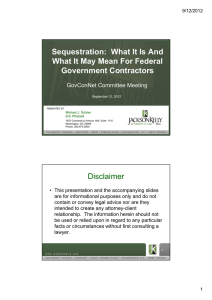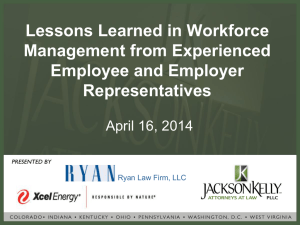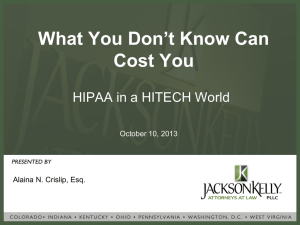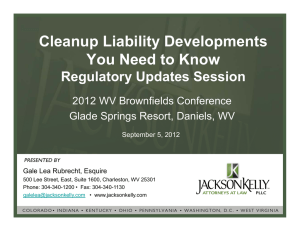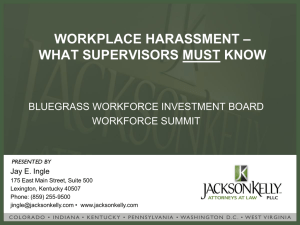Managing Legal Liability – A Safety and Health Perspective March 29, 2011
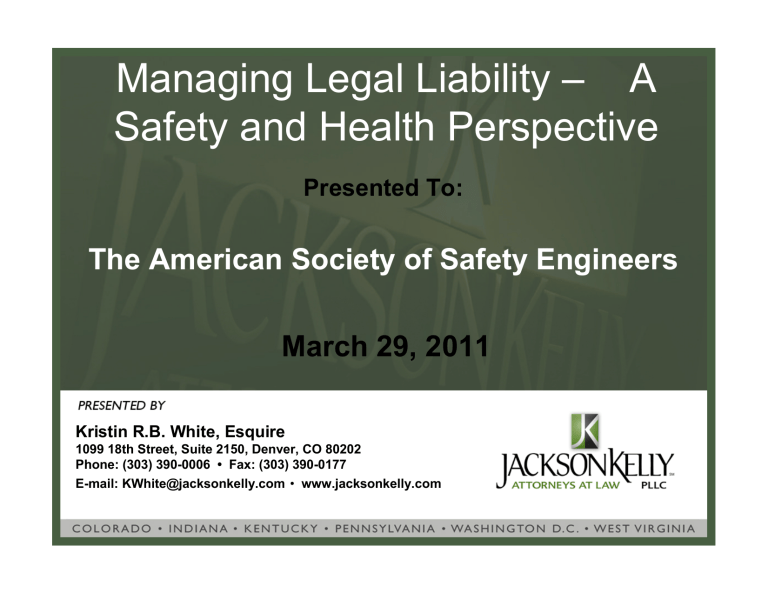
Managing Legal Liability – A
Safety and Health Perspective
Presented To:
The American Society of Safety Engineers
March 29, 2011
Kristin R.B. White, Esquire
1099 18th Street, Suite 2150, Denver, CO 80202
Phone: (303) 390-0006 • Fax: (303) 390-0177
E-mail: KWhite@jacksonkelly.com
• www.jacksonkelly.com
Laura E. Beverage
Page H. Jackson
Dana M. Svendsen
Karen L. Johnston
Christopher G. Peterson
Kristin R.B. White
JACKSON KELLY PLLC
1099 18th Street, Suite 2150
Denver, Colorado 80202
Phone: (303) 390-0003
Fax: (303) 390-0177 w w w . j a c k s o n k e l l y . c o m
2
Workplace safety and health laws establish regulations designed to eliminate personal injuries and illnesses from occurring in the workplace.
3 w w w . j a c k s o n k e l l y . c o m
• These laws consist primarily of federal and state statutes.
• Federal laws and regulations preempt state ones where they overlap or contradict one another.
w w w . j a c k s o n k e l l y . c o m
4
U.S. Constitution
Congress justifies the Occupational Safety and Health Act because of the impact of workplace-related injuries and illness on interstate commerce, which Congress can regulate under the commerce clause of the
U.S. Constitution.
5 w w w . j a c k s o n k e l l y . c o m
Federal Statutes
• Bills that have been passed by
Congress and signed by the President become a federal statute.
w w w . j a c k s o n k e l l y . c o m
6
Federal Regulations
• Federal regulations are the actual enforceable laws authorized by major legislation enacted by Congress.
w w w . j a c k s o n k e l l y . c o m
7
State Statutes
• Bills that have been passed by the legislature and signed by the governor become a state statute.
– State statutes that violate the U.S.
Constitution may be struck down by the
Supreme Court if the issue is appealed to the Court.
8 w w w . j a c k s o n k e l l y . c o m
Common Law
• Body of law that is based on the custom and general principles and that, embodied in case law, serves as precedent or is applied to situations not covered by statute.
• Under the common-law system, when a court decides and reports its decision concerning a particular case, that case becomes part of the body of law and can be used in later cases involving similar matters.
9 w w w . j a c k s o n k e l l y . c o m
Common Law
• Basic law of contracts, torts, and property do not exist in statute, but only in common law.
w w w . j a c k s o n k e l l y . c o m
10
Occupational Safety and Health Act
• Congress enacted this legislation under its constitutional grant of authority to regulate interstate commerce.
– 29 U.S.C. §§ 651 - 678
11 w w w . j a c k s o n k e l l y . c o m
LEGAL LIABILITIES UNDER OSHA
• Civil penalties for each “willful” and
“repeat” violation may be assessed up to $70,000 per violation, with a minimum fine of $5,000 for each willful violation. [§ 17(a)]
• For each “serious” or “non-serious” violation, the maximum civil penalty is
$7,000. [§ 17(b)]
12 w w w . j a c k s o n k e l l y . c o m
WILLFULNESS:
• Willfulness has been defined as deliberate indifference to the facts or law, of which the employer has actual rather than constructive knowledge .
• Willfulness may also include actual knowledge of significant risks coupled with steps to avoid additional information about those risks .
13 w w w . j a c k s o n k e l l y . c o m
OSHA Regulations
• 29 CFR Part 1910
– General industry regulations
• 29 CFR Part 1926
– Construction regulations w w w . j a c k s o n k e l l y . c o m
14
OSHA is a regulatory agency empowered to create and enforce these regulations.
w w w . j a c k s o n k e l l y . c o m
15
OSHA’s SPRING 2011
REGULATORY AGENDA
• Development of Injury and Illness
Prevention Program (I2P2)
– Would require that employers develop a plan, with worker participation, to identify the hazards present in their worksites and address them before they cause an injury, illness, or death.
16 w w w . j a c k s o n k e l l y . c o m
OSHA Rulemaking
• Procedural Requirements
– Executive orders and statutes
– Administrative Procedures Act
– OSHA Act
• “Notice and comment” rulemaking required by the OSH Act and APA
• Publication in the Federal Register
17 w w w . j a c k s o n k e l l y . c o m
Managing Legal Liability in This Framework
• Four Main Areas:
– Audit and Compliance
– Incident and Investigation
– Inspection Plans
– Litigation w w w . j a c k s o n k e l l y . c o m
18
Internal Safety Audits –
Benefits and Pitfalls
w w w . j a c k s o n k e l l y . c o m
19
INTERNAL SAFETY AUDITS OR
SELF-CRITICAL ANALYSIS
• There are many reasons for an employer to consider undertaking internal safety audits, or other forms of “self-critical analysis,” as well as internal investigations.
• May point out deficiencies in the company’s operations or unearth potential misconduct.
w w w . j a c k s o n k e l l y . c o m
20
INTERNAL SAFETY AUDITS
• The legal audit, otherwise known as an internal safety audit, is a form of self-critical analysis intended to be preventive in nature.
• This type of analysis should be differentiated from statutorily required internal investigations, particularly under the OSH
Act.
• Many entities find that internal safety audits and self-critical analyses are the linchpin of an effective safety and health program.
21 w w w . j a c k s o n k e l l y . c o m
INTERNAL SAFETY AUDITS
• Before embarking on a self-critical analysis path, the internal decision must be made that the potential harm of disclosure of the documents developed as a result of the selfcritical analysis will be outweighed by the benefit obtained from their use in the prevention of accidents and other safety and health problems.
22 w w w . j a c k s o n k e l l y . c o m
INTERNAL SAFETY AUDITS
• It is not always possible to protect preventive self-audit materials from disclosure.
– The attorney-client privilege and the attorney work product doctrine may be utilized to provide some measure of protection for materials generated in an internal investigation.
– Preventive safety audits are not afforded such protection.
23 w w w . j a c k s o n k e l l y . c o m
INTERNAL SAFETY AUDITS
• Any employer engaging in a preventive audit should bear in mind that the written material created may well be subject to disclosure.
– Employers should take all reasonable steps to ensure that deficiencies identified in the audit are promptly corrected.
• This alone may be the employer’s best defense to an agency’s attempt to use a selfcritical audit against the operator.
24 w w w . j a c k s o n k e l l y . c o m
Investigations of Accidents and Incidents-
A Proactive and Cautious Approach
25 w w w . j a c k s o n k e l l y . c o m
INVESTIGATIONS OF ACCIDENTS
AND INCIDENTS
• Additional types of documents may be generated by an employer during the course of internal investigations, whether mandated by law or governed by company policy.
26 w w w . j a c k s o n k e l l y . c o m
INVESTIGATIONS OF ACCIDENTS
AND INCIDENTS
• Documents that may result from an internal investigation include:
– Notes and minutes from company meetings
– Internal memoranda
– Draft reports
• Causation, root cause or safety factor analyses, and documentation of re-enactments
– Diagrams
– Drawings
– Photographs
– Videotape w w w . j a c k s o n k e l l y . c o m
27
INVESTIGATIONS OF ACCIDENTS
AND INCIDENTS
• Interview notes of company employees may also result from the investigation.
• If experts and consultants are retained by the company during the course of the investigation, these documents may be generated:
– Correspondence with the consultant
– Reports containing expert conclusions and opinions
28 w w w . j a c k s o n k e l l y . c o m
INVESTIGATIONS OF ACCIDENTS
AND INCIDENTS
• Preventing Disclosures
– As with the preventive self-audit materials, it is not always possible to protect internal investigative materials from disclosure.
– In determining how best to conduct an internal investigation so as to protect materials, there are two doctrines which provide some measure of protection and with which the reader should be familiar:
1.the attorney-client privilege
2.the attorney work product privilege
29 w w w . j a c k s o n k e l l y . c o m
INVESTIGATIONS OF ACCIDENTS
AND INCIDENTS
• Preventing Disclosures
– Where an investigation is conducted by or at the direction of counsel, or otherwise in anticipation of litigation, the attorney-client privilege or the attorney work product privilege may apply to the materials generated during the course of the investigation and the information learned.
30 w w w . j a c k s o n k e l l y . c o m
w w w . j a c k s o n k e l l y . c o m
Inspection Plan
31
BE PREPARED
Before an Inspection Starts
• Legal rights and responsibilities
• The inspection process w w w . j a c k s o n k e l l y . c o m
32
KNOW YOUR RIGHTS
• OSHA must have a warrant to enter into an employer’s premises unless the employer waives that requirement.
• Representatives of the employer and employees have the right to accompany the inspector.
w w w . j a c k s o n k e l l y . c o m
33
© Jackson Kelly PLLC 2010
KNOW YOUR RIGHTS
• The employer must make available for review only those documents that the employer is required to maintain by the OSH Act and
OSHA regulations.
• The OSH Act permits OSHA compliance officers to conduct private interviews of employees. However, the employee must give his or her consent to such interview.
34 w w w . j a c k s o n k e l l y . c o m
INSPECTION PLAN
• Be prepared for the inspection by having an effective safety and health program in place.
• Be cooperative with your compliance officer, but understand your rights and the limits of the officer’s authority.
35 w w w . j a c k s o n k e l l y . c o m
INSPECTION PLAN
Actively participate in the inspection and accompany the compliance officer at all times.
Duplicate all the samples, photographs, and data collected by the inspector.
Document any alleged violations before they are corrected and after abatement occurs.
36 w w w . j a c k s o n k e l l y . c o m
INSPECTION PLAN
Do not make admissions against interest during inspection and do not speculate.
Effectively participate in the opening and closing conferences.
Be prepared to challenge the issuance of the enforcement action, if necessary.
37 w w w . j a c k s o n k e l l y . c o m
Litigation – Understand the
Process
w w w . j a c k s o n k e l l y . c o m
38
The OSHA Citation
• Lists the regulation allegedly violated and severity of the violation.
• Documents the factual circumstances allegedly violating the regulation.
• Proposes the penalty for the alleged violation within the statutory limits.
w w w . j a c k s o n k e l l y . c o m
39
Informal Conference
w w w . j a c k s o n k e l l y . c o m
40
THE INFORMAL
PRE-CONTEST CONFERENCE
• Checklist for successful participation in an informal conference
Gather facts to support the lack of a violation or any mitigating factors.
- Consider helpful evidence that is available.
- Research legal support for your position.
- Are there any affirmative defenses available?
- Does the evidence support OSHA’s characterizations of the alleged violations, i.e.
, serious, willful, repeated, etc.?
41 w w w . j a c k s o n k e l l y . c o m
Notice of Contest
• Contest citation or penalty within 15 working days of receipt of citation
– 29 U.S.C. § 659(a) w w w . j a c k s o n k e l l y . c o m
42
Litigation with the Department of Labor
• Entitlement to a due process hearing before the Occupational Safety and
Health Review Commission.
w w w . j a c k s o n k e l l y . c o m
43
For more information on these and other occupational safety and health topics, please visit:
http://safety-health.jacksonkelly.com/
Kristin R.B. White, Esquire
1099 18th Street, Suite 2150, Denver, CO 80202
Phone: (303) 390-0006 • Fax: (303) 390-0177
E-mail: kwhite@jacksonkelly.com • www.jacksonkelly.com
w w w . j a c k s o n k e l l y . c o m
